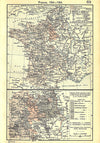Bordeaux History
February 26, 2017

The wine was introduced to the Bordeaux region by the Romans, probably in the mid-1st century, to provide wine for local consumption, and wine production has been continuous in the region since then.
In the 12th century, the popularity of Bordeaux wines in England increased dramatically following the marriage of Henry Plantagenet and Eleanor of Aquitaine.[4] The marriage made the province of Aquitaine part of the Angevin Empire, and thenceforth the wine of Bordeaux was exported to England. At this time, Graves was the principal wine region of Bordeaux, and the principal style was clairet. This accounts for the ubiquity of claret in England. The export of Bordeaux was interrupted by the outbreak of the Hundred Years' War between France and England in 1337. By the end of the conflict in 1453 France had repossessed the province, thus taking control of wine production in the region.[4] As part of the Auld Alliance, Scots merchants were granted by the French a privileged position in the trade of claret, a position which continued largely unchanged with the cession of the military alliance between France and Scotland with the signing of the Treaty of Edinburgh. Even when the by then Protestant kingdoms of England and Scotland, both ruled by the same Stuart king by this point, were trying to militarily aid the Huguenot rebels in their fight against Catholic France in La Rochelle, Scots trading vessels were not only permitted to enter the Gironde, but they were escorted safely to the port of Bordeaux by the French navy for their own protection from Huguenot privateers.
In the seventeenth century, Dutch traders drained the swampy ground of the Médoc in order that it could be planted with vines, and this gradually surpassed Graves as the most prestigious region of Bordeaux. Malbec was the dominant grape here, until the early 19th century, when it was replaced by Cabernet Sauvignon.
In 1855, the châteaux of Bordeaux were classified; this classification remains widely used today. From 1875–1892 almost all Bordeaux vineyards were ruined by Phylloxera infestations. The region's wine industry was rescued by grafting native vines on to pest-resistant American rootstock.
Leave a comment
Comments will be approved before showing up.
